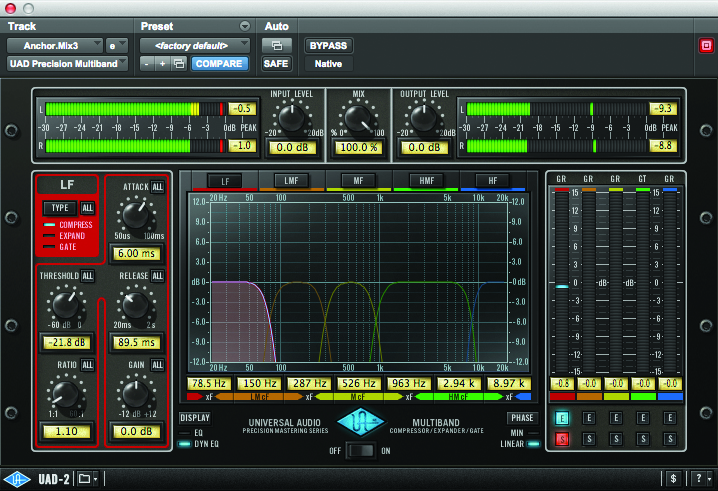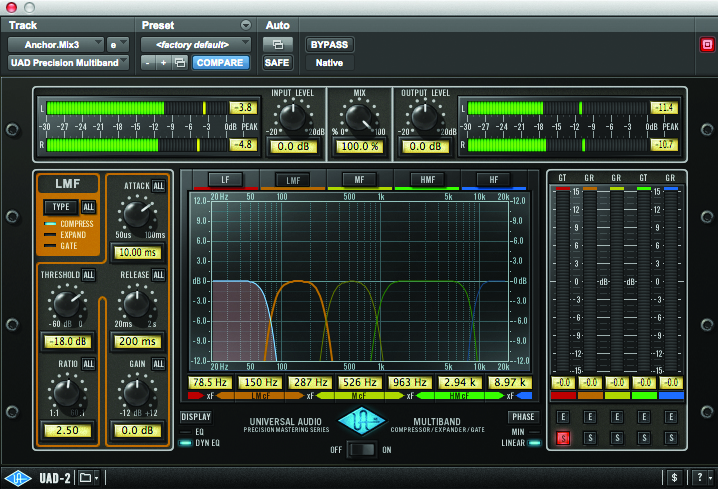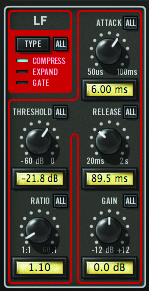Mastering: The Tutorials Part Two
Mike Hillier continues his step-by-step guides to mastering with a look at multiband compressors, key technical terms and useful links and tips… Setting a Multiband Compressor 1: Add an instance of your multiband compressor to the mastering chain – we usually place it just before our full-band compressor, if we’re using one. 2: Here, we’re […]

Mike Hillier continues his step-by-step guides to mastering with a look at multiband compressors, key technical terms and useful links and tips…
Setting a Multiband Compressor

1: Add an instance of your multiband compressor to the mastering chain – we usually place it just before our full-band compressor, if we’re using one.

2: Here, we’re using the UAD Precision Multiband. We’ve used the solo band function to solo only the lowest-frequency band, and we’ve scrubbed through the range to find the cut-off frequency that is just the sub-frequencies of the kick. You don’t need to use every band, usually one or two is more than enough.

3: Turn the solo band off to hear the whole mix. If you have the option, be sure to use linear-phase crossovers. Engage that mode, as this will produce the least phase distortion in your mix, although it will also produce the greatest amount of latency.

4: Use a very low ratio, a moderate attack and a closely timed release, and dial down the threshold until gain reduction starts to bring the compressor into action.

5: If need be, set the compressor to act a little too heavily while you fos in on your attack and release settings, then dial the threshold and ratio back down.

6: Finally, bypass the effect and compare the processed signal with the unprocessed version to be sure that you have made an improvement to the master.
Mastering – Addendum
Quiztones
Another excellent tool for improving your critical listening is Quiztones from Audiofile Engineering. This application lets you test your ability to hear frequencies (both using sine waves, or EQ applied to music) and gain differences. Quiztones is available for Mac, iOS and Android: http://quiztones.com
DDPi
The final process in mastering is often to supply the necessary files for the replication in whatever formats are required. For digital distribution, this may only be 24-bit .WAV files, but for CDs a special DDPi file is required. Some DAWs can export DDPi files natively, while others may require a dedicated DDPi plugin, such as the HOFA DDP Generator – see http://hofa-plugins.de/en.
Mastering Reverb
Reverb is not a process that is used often in mastering, and while many all-in-one mastering applications will include a reverb, it should be reserved for the rare occasions when you are fixing a bad mix, or trying to match two disparate mixes recorded in different locations.
ISRC
In addition to the audio, metadata can be stored in some file formats. The most important of these is the ISRC code. ISRC codes are the International Standard Recording Codes, used to uniquely identify songs, similar to ISBN codes on books. Each code should be 12 characters long, and will help royalty collection agencies to identify recordings in order to make payments. You can buy them and get more info from the PPL: www.ppluk.com/I-Make-Music/Why-Should-I-Become-A-Member/What-is-an-ISRC.
Daniel Pattison
Like in the Final Mixdown feature, we have again chosen to look at Anchor by HART in this article (www.facebook.com/hart.musica). The track was recorded by Ben Walker (www.bensroom.co.uk) with additional recordings by Mario Leal and George Murphy and string arrangements by Nico Muhly. The track was mixed by Mario Leal (www.mario-leal.com).
Using Outboard
If you really want to make it as a mastering engineer, sooner or later you’re going to need to invest in some outboard analogue hardware. Mastering versions of many compressors and EQs are available, but frequently at much-inflated prices compared to the standard versions. This is because instead of potentiometers, mastering editions usually have switches with dedicated stereo-matched resistors to ensure far superior stereo accuracy and improved recall, often within 0.1dB.
Monitoring
Nearfield monitors are the de facto standard in mixing, and many mastering engineers also rely on them, but a good pair of full-range speakers can be just as useful in a mastering environment. ATC and PMC are the most common names to be found in the big-budget mastering houses, but Unity Audio, Genelec and Barefoot all make slightly more affordable full-range monitors.
Headphones
A good pair of open-back headphones can be of great assistance when mastering. However, it can also be useful to have a pair of cheaper earbud-style headphones to listen back to how a great proportion of your listeners will hear the end result. It’s one thing making a master sound great on expensive systems, but many consumers use laptop speakers or earbuds, so check your masters on these, too.
